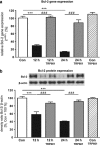Prevention of neonatal oxygen-induced brain damage by reduction of intrinsic apoptosis
- PMID: 22237207
- PMCID: PMC3270267
- DOI: 10.1038/cddis.2011.133
Prevention of neonatal oxygen-induced brain damage by reduction of intrinsic apoptosis
Abstract
Within the last decade, it became clear that oxygen contributes to the pathogenesis of neonatal brain damage, leading to neurocognitive impairment of prematurely born infants in later life. Recently, we have identified a critical role for receptor-mediated neuronal apoptosis in the immature rodent brain. However, the contribution of the intrinsic apoptotic pathway accompanied by activation of caspase-2 under hyperoxic conditions in the neonatal brain still remains elusive. Inhibition of caspases appears a promising strategy for neuroprotection. In order to assess the influence of specific caspases on the developing brain, we applied a recently developed pentapeptide-based group II caspase inhibitor (5-(2,6-difluoro-phenoxy)-3(R,S)-(2(S)-(2(S)-(3-methoxycarbonyl-2(S)-(3-methyl-2(S)-((quinoline-2-carbonyl)-amino)-butyrylamino)propionylamino)3-methylbutyrylamino)propionylamino)-4-oxo-pentanoic acid methyl ester; TRP601). Here, we report that elevated oxygen (hyperoxia) triggers a marked increase in active caspase-2 expression, resulting in an initiation of the intrinsic apoptotic pathway with upregulation of key proteins, namely, cytochrome c, apoptosis protease-activating factor-1, and the caspase-independent protein apoptosis-inducing factor, whereas BH3-interacting domain death agonist and the anti-apoptotic protein B-cell lymphoma-2 are downregulated. These results coincide with an upregulation of caspase-3 activity and marked neurodegeneration. However, single treatment with TRP601 at the beginning of hyperoxia reversed the detrimental effects in this model. Hyperoxia-mediated neurodegeneration is supported by intrinsic apoptosis, suggesting that the development of highly selective caspase inhibitors will represent a potential useful therapeutic strategy in prematurely born infants.
Figures






Similar articles
-
Targeting neonatal ischemic brain injury with a pentapeptide-based irreversible caspase inhibitor.Cell Death Dis. 2011 Sep 1;2(9):e203. doi: 10.1038/cddis.2011.87. Cell Death Dis. 2011. PMID: 21881605 Free PMC article.
-
The common antitussive agent dextromethorphan protects against hyperoxia-induced cell death in established in vivo and in vitro models of neonatal brain injury.Neuroscience. 2014 Aug 22;274:260-72. doi: 10.1016/j.neuroscience.2014.05.059. Epub 2014 Jun 6. Neuroscience. 2014. PMID: 24912029
-
Activation of caspase-9, but not caspase-2 or caspase-8, is essential for heat-induced apoptosis in Jurkat cells.J Biol Chem. 2010 Dec 24;285(52):40525-33. doi: 10.1074/jbc.M110.167635. Epub 2010 Oct 26. J Biol Chem. 2010. PMID: 20978129 Free PMC article.
-
Inhibition of Caspase 3 and Caspase 9 Mediated Apoptosis: A Multimodal Therapeutic Target in Traumatic Brain Injury.Curr Neuropharmacol. 2023;21(4):1001-1012. doi: 10.2174/1570159X20666220327222921. Curr Neuropharmacol. 2023. PMID: 35339178 Free PMC article. Review.
-
Caspase-2: the orphan caspase.Cell Death Differ. 2012 Jan;19(1):51-7. doi: 10.1038/cdd.2011.157. Epub 2011 Nov 11. Cell Death Differ. 2012. PMID: 22075987 Free PMC article. Review.
Cited by
-
Erythropoietin modulates autophagy signaling in the developing rat brain in an in vivo model of oxygen-toxicity.Int J Mol Sci. 2012 Oct 10;13(10):12939-51. doi: 10.3390/ijms131012939. Int J Mol Sci. 2012. PMID: 23202931 Free PMC article.
-
Recombinant Slit2 attenuates neuronal apoptosis via the Robo1-srGAP1 pathway in a rat model of neonatal HIE.Neuropharmacology. 2019 Nov 1;158:107727. doi: 10.1016/j.neuropharm.2019.107727. Epub 2019 Jul 26. Neuropharmacology. 2019. PMID: 31356825 Free PMC article.
-
A Novel Model for Simultaneous Evaluation of Hyperoxia-Mediated Brain and Lung Injury in Neonatal Rats.Cells. 2025 Mar 16;14(6):443. doi: 10.3390/cells14060443. Cells. 2025. PMID: 40136692 Free PMC article.
-
Arginase 2 deficiency reduces hyperoxia-mediated retinal neurodegeneration through the regulation of polyamine metabolism.Cell Death Dis. 2014 Feb 20;5(2):e1075. doi: 10.1038/cddis.2014.23. Cell Death Dis. 2014. PMID: 24556690 Free PMC article.
-
Oxygen toxicity: cellular mechanisms in normobaric hyperoxia.Cell Biol Toxicol. 2023 Feb;39(1):111-143. doi: 10.1007/s10565-022-09773-7. Epub 2022 Sep 16. Cell Biol Toxicol. 2023. PMID: 36112262 Free PMC article. Review.
References
-
- Johnson S, Wolke D, Hennessy E, Marlow N. Educational outcomes in extremely preterm children: neuropsychological correlates and predictors of attainment. Dev Neuropsychol. 2011;36:74–95. - PubMed
-
- Keller M, Felderhoff-Mueser U, Lagercrantz H, Dammann O, Marlow N, Hüppi P, et al. Policy benchmarking report on neonatal health and social policies in 13 European countries. Acta Paediatr. 2010;99:1624–1629. - PubMed
-
- Felderhoff-Mueser U, Sifringer M, Polley O, Dzietko M, Leineweber B, Mahler L, et al. Caspase-1-processed interleukins in hyperoxia-induced cell death in the developing brain. Ann Neurol. 2005;57:50–59. - PubMed
-
- Gerstner B, Sifringer M, Dzietko M, Schüller A, Lee J, Simons S, et al. Estradiol attenuates hyperoxia-induced cell death in the developing white matter. Ann Neurol. 2007;61:562–573. - PubMed
Publication types
MeSH terms
Substances
LinkOut - more resources
Full Text Sources
Other Literature Sources
Research Materials

